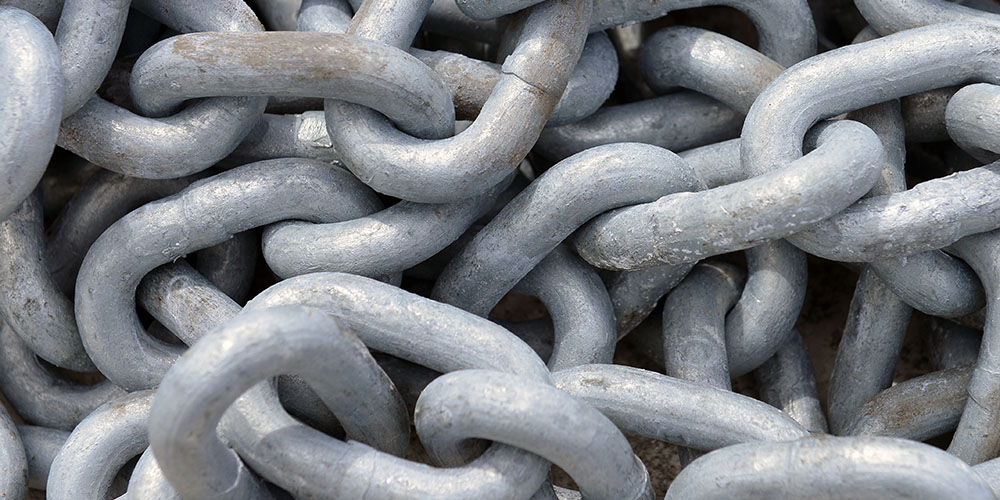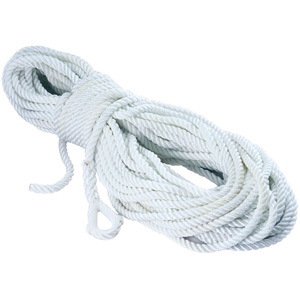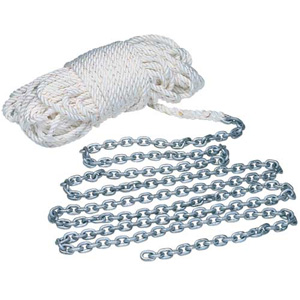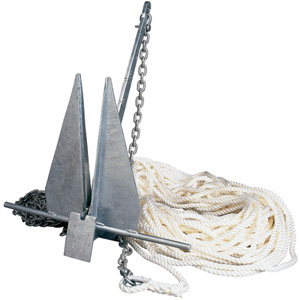
When choosing an anchor rode, first ask yourself what depths and conditions you generally anchor in. If you mostly anchor in protected coves in shallow lakes, then your anchor rode needs will be different than the needs of ocean boaters anchoring in deeper water who need their anchor to hold overnight and stand up to squalls, swells and other ocean conditions that might break an anchor loose.
We'll walk you through different anchor rode types and help you find the right one for your boat.
- Types of Anchor Rodes
- Anchor Chain Types
- How Long Should Your Anchor Rode Be?
- Matching Line and Chain Size to Your Boat Length
- Matching Your Rode to a Windlass
- Anchor Rode Reccomendations for Different Boat Types
- Conclusion and Main Anchor Rode Selection Points
Types of Anchor Rodes

All-nylon rodes like this Economy Pre-spliced Anchor Line are great for small boats.
Anchor rodes consist of a length of chain, rope or a combination of rope and chain that connects an anchor to a boat. The rope portion of anchor rodes typically consists of nylon three-strand, 12-strand or double-braid line. Nylon is the material of choice, because it is elastic and able to absorb the shock loads encountered when anchoring. Polyester or other materials should not be used for anchor rodes.
All-Rope Rodes
Many small boats use anchor rodes made entirely of three-strand nylon anchoring line. This is because all-rope rodes are lightweight, inexpensive and easier to stow than rope-chain or all-chain rodes. Although all-rope rodes can be quite strong, they lack the chafe resistance of chain and are therefore not appropriate for anchoring near coral, among rocks or in anchorages with lots of surge and wave action. However, for smaller boats, as the rode for a "lunch hook" or other temporary anchoring in calm conditions, an all-rope rode can be a resonable choice.
Rope-Chain Rodes
Adding chain to your rode serves two functions:
- To protect the nylon line from chafing on the bottom
- To weigh down the anchor rode allowing it to lay flat on the bottom and keep the pull on the anchor horizontal
The rule of thumb for the chain portion of these rodes is typically half a boat to a full boat length of chain, meaning for a 30 ft boat you would want 15 to 30 ft of chain. The exception to this rule is when you are anchoring in a particularly rocky bottom. Many boaters recommended running as little as 4 ft of chain on rocky bottoms to avoid the chain getting caught on rocks or debris possibly causing you to lose your anchor. If you frequently anchor in different conditions, consider keeping multiple anchor and rode setups on your boat if you have enough storage space for them. This will give you different anchoring options depending on the conditions you're anchoring in.
One drawback of rope-chain anchor rodes is that they are not abrasion resistant over their entire length and they are not as heavy as all chain rodes meaning it may not have enough weight to fully lay on the bottom and keep the pull on the anchor horizontal especially in windy conditions.
A second drawback of this type of rode derives from the connection between the rope and the chain which consists of a stainless steel or galvanized shackle and thimble. This connection is bulky, has the potential to work loose if not seized using wire and is also incompatible with windlasses. You can avoid these problems by running a rope-chain spliced rode instead.

Rope-Chain Anchor Rode Packages have a rope-to-chain splice that will run over the gypsy of your windlass.
Rope-Chain Spliced Rodes
To overcome the drawback described above, many boaters splice their nylon line directly to the last link of chain, a technique originally developed for self-tailing windlasses. This produces a very sleek rode which stows easily, passes through a chain pipe more easily than a splice/thimble, and which retains about 90% of the breaking strength of the line. Learning to splice rope to chain isn't particularly difficult, but if you don't feel comfortable doing the job then just about any marine shop can handle the job for you. You can find a qualified shop in your area using our Find a Pro tool.
All-Chain Rodes
Larger boats with windlasses frequently have an all-chain rode. This reduces the need for long scope (except in shallow water) because the chain is heavy and lies on the bottom until severe conditions are encountered, when more scope may be required. Since chain has very little elasticity, care should be taken to prevent the chain from becoming "bar tight" in high winds by using a snubber made of nylon line.
What's an Anchor Rode Snubber?
An anchor snubber acts as a sort of shock absorber for all-chain anchor rodes. It consists of a section of nylon line spliced to a hook at one and branched off to two sections of nylon line on the opposite end. The two branched nylon lines have a loop at the end of each of them which slip over the forward cleats on your boat near the windlass. The hook an the end hooks into the chain on the anchor rode once it is under load. Once the snubber is tight, you can let out more anchor rode which will remain loose since the snubber is now carraying the anchor line. This will reduce the amount of load being transfered from the chain to the boat as swells come through since the flexible nylon line will give much more than the rigid chain will.
Drawback of All-Chain Rodes
The drawbacks to all-chain rode are weight, expense, and the need for a windlass. A windlass and all-chain rode may add 300 to 600 pounds in the bow and can adversely affect the performance of your boat. Many owners of modern, lightweight cruising boats are not willing to suffer the reduced speed and increased pitching caused by this extra weight.

Rope-to-chain splice
Anchor Chain Types
There are three main factors to look for when selecting chain for your rode:
- Strength
- Corrosion resistance
- Chain pitch uniformity
High-Test: Grade 43, called G4 or HT; made from high-carbon steel. G4 is the preferred chain for anchoring or windlass applications, and has twice the working load of BBB chain, so you can use a smaller size with the same strength.
BBB: Grade 30; made from low-carbon steel. BBB or "Triple B" has a uniform pitch short link, and works well on windlass gypsies. BBB used to be the most popular type for windlass designs of the past, but has been replaced by G4.
Proof Coil: Does not have a uniform pitch and does not work with anchor windlasses.
Grade 70: Called G7 or Transport Chain; extremely high strength-to-weight ratio, is substantially stronger than G4 High Test, and resists wear because of its exceptional hardness properties. Compatible with very few windlasses, but recommended by some noted cruising authorities.
Matching Line and Chain Size to Your Boat Length
When recommending anchor rodes we generally use the following guidelines:
- Heavy or high windage boats should use 1/8" of diameter for every 8' of boat length
- "Normal" boats can use 1/8" diameter for every 9' of boat length
- Lightweight or low windage boats can use 1/8" of diameter for every 10' of boat length
- BBB chain should be half the line diameter (1/2" nylon line would be matched to 1/4" galvanized chain)
- Use shackles one size larger than the chain (1/4" chain would use 5/16" shackles)
In general the load on an anchor line varies with the square of the LOA of the boat. A high windage, heavy displacement boat such as a trawler or fishing boat will require heavier anchor rode than an ultra-light racing sailboat of the same LOA. As a general guide, for winds up to 30 knots, we recommend the following anchor line and chain diameters, using three-strand, high quality line. This table assumes an 8:1 working load ratio.
| Light Boat | Medium Boat | Heavy Boat | 3-Strand Nylon Dia. | Chain Dia. |
|---|---|---|---|---|
| 26'–30' | 23'–27' | 21'–24' | 3/8" | 3/16" PC |
| 31'–35' | 28'–32' | 25'–28' | 7/16" | 1/4" PC |
| 36'–40' | 32'–36' | 29'–32' | 1/2" | 1/4" PC |
| 41'–45' | 37'–40' | 33'–36' | 9/16" | 5/16" PC/BBB or 1/4" HT |
| 46'–50' | 41'–45' | 37'–40' | 5/8" | 5/16" PC/BBB/HT |
| 51'–60' | 46'–54' | 41'–48' | 3/4" | 3/8" PC/BBB or 5/16" HT |
| 61'–70' | 55'–63' | 49'–56' | 7/8" | 1/2" PC or 3/8" HT |
| 71'–80' | 64'–72' | 57'–64' | 1" | 5/8" PC or 1/2" HT |
Matching Your Rode to a Windlass
Every anchor windlass is equipped with a gypsy, the wheel or capstan on the winch that hauls the rope and/or chain up and down. Each gypsy fits one or more diameters of line (of three-strand, eight-strand or twelve-strand construction) and specific types and diameters of chain (like 1/2 Grade 43, 5/16" BBB or 3/8" Grade 70, for example). Start by choosing the appropriately sized rode for your boat length and weight and then find a windlass that is compatible with your rode. The gypsy and rode must be an exact match, and most windlasses are available with a choice of gypsies to fit different line and chain types.
How Long Should Your Anchor Rode Be?
To determine how long your rode should be we first need to talk about anchor scope. Anchor scope is the ratio of how much anchor rode is payed out compared to the depth of the water you are anchoring in. An anchor scope of 7:1 is generally considered ideal meaning that for every foot of depth you're anchoring in you would pay out 7 feet of anchor rode. For example, if you are anchoring in water 10 ft deep, you would need to let out 70 ft of anchor rode to achieve 7:1 scope. High scope like this isn't always possible in crowded anchorages though due to how much your boat will swing so many boaters will compromise with 5:1 scope
Having appropriate scope becomes even more important in shallow waters as well. While it may seem counterintuitive, this is because swells have a larger impact on your anchor rode angle in shallow waters than in deeper waters.
Proper Scope With All-chain Rodes
Determining the length of anchor chain is based on the maximum water depth and the freeboard of the vessel, but since chain is so heavy, generally you can plan on using 4:1 scope. Due to the weight of the chain, you actually need less scope as the water depth increases. Many boats will use 200–250' of chain. Others may use 200' of chain and then bend on another 300' of line for extremely deep anchorages. Regardless of whether you use nylon rode, it's extremely important that boats with chain rode have some nylon at the bitter end so that the anchor rode can be cut in an emergency.
Small Boat Anchor Rodes and Anchor/Rode Packages

Our West Marine Traditional Anchor and Rode Package has everything the small boat operator needs in one package. Choose between a 4lb., 8lb. or 13lb. Traditional Anchor.
The simplest anchor rode involves connecting the anchor directly to a spliced nylon anchor line. An example uses a West Marine 8lb. Traditional Anchor, a 1/4" shackle, and a 3/8" x 150' New England Ropes anchor line. This is great for day use with a small boat. It's lightweight, inexpensive, and will hold well as long as the scope is sufficient.
To make this anchor package even more effective, you can add a short length of chain between the anchor and the line. The classic rule is to add a boat length of chain, which does two things: it protects the nylon line from chafe caused by seabed rocks and debris, and the chain's weight keeps the angle of pull on the anchor parallel to the bottom. But even a short length, like 4 feet of coated ACCO chain, will make a big improvement in anchor performance and the longevity of the system.
Small galvanized shackles connect the anchor to the length of chain, and attach the chain to the thimble on the anchor line. Remember to use the "next size up" in shackles; a length of 1/4" chain would be matched to a 5/16" shackle. This system, with a long length of three-strand nylon line, a moderate length of chain and a properly sized anchor will satisfy the needs of the majority of boaters, with boats up to the 30' size range.
Big Boat Anchor Rodes
If you own a boat over 40' of length and cruise to lots of different anchorages with a variety of seabed types, you should consider an all-chain anchor rode. There's nothing like the feeling of security provided by the strength and abrasion resistance of chain for open-water and heavy-weather anchorages.
The negative side of chain is its weight. Since boats require 200' or more of chain for an all-chain rode, and since chain is very heavy, all that chain adds up to a buanch of weight in the bow of a boat. That's why many boaters (and especially sailboat owners with big and lightweight boats) choose higher-strength Grade 43 or Grade 70 chain. High-strength chain like these enables you to go down a size which reduces the chain's weight by about 30%, while achieving the same working load capacity and ultimate strength.
Matching anchor chain to a specific vessel can be challenging, since the windage of the vessel is probably the key selection factor, and windage is hard to determine. You might want to consult a naval architect or marine surveyor for advice on how to size ground tackle on boats over 60' or so. Our West Advisor articles have suggestions on how to size this gear on boats up to about 60' or 70'.
Conclusion
Alright, we know that was a lot of info, so here are the highlights you need to remember when choosing a rode for your boat:
- Make you sure you rode is long enough to achieve 7:1 scope in the deepest water you expect to anchor in. You can get away with less scope in some situations, but it's best to be prepared for 7:1 so you have it when you need it.
- Add a length of chain equal to the length of your boat to your anchor rode to make it hold more effectively and avoid chaffing along the bottom. You can use a length of chain as short as 4 ft in rocky bottoms to avoid having your chain get caught on rocks and risk losing your anchor
- Use the line and chain diameter chart above to appropriately size your rode based on your boat length and weight
- If you add a windlass, make sure that the gypsy of the windlass is compatible with the chain and line diameter of your rode
Need More Help?
West Marine is the perfect place to get ready for your next trip. With knowledgeable staff in store, we can help you find the right anchor rode for your boat so you can anchor securely anywhere your adventures take you. Find your store here.






